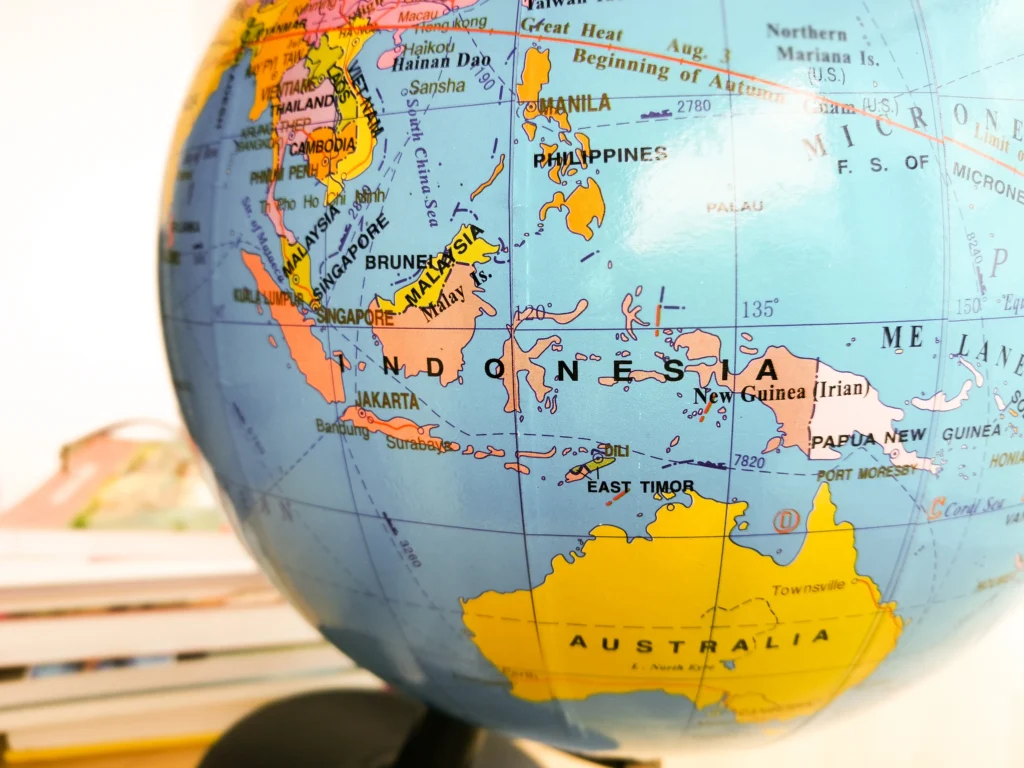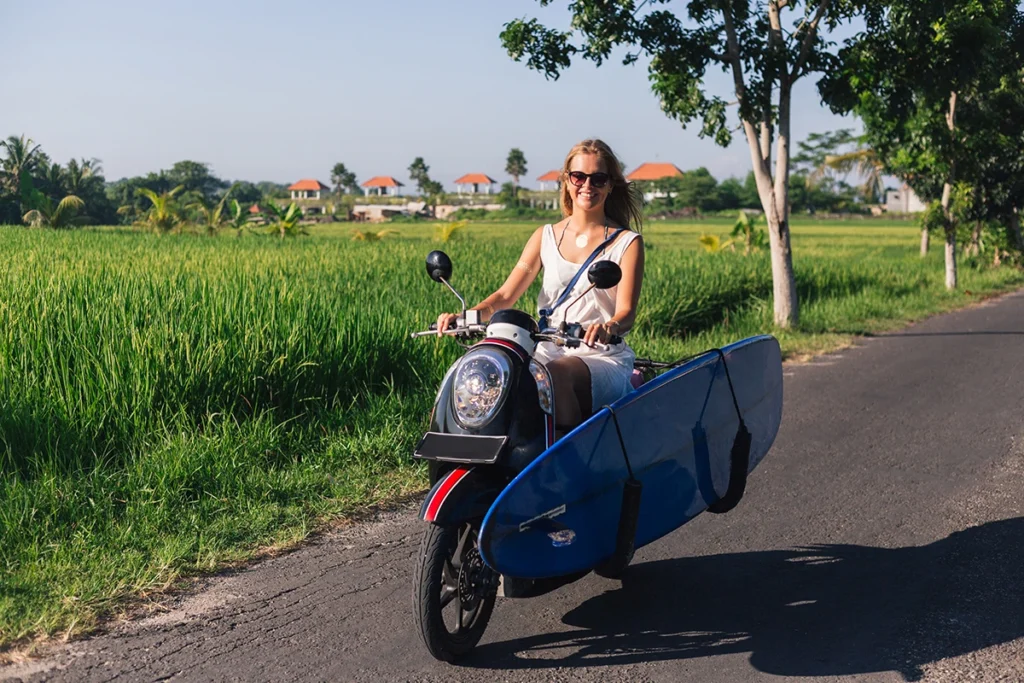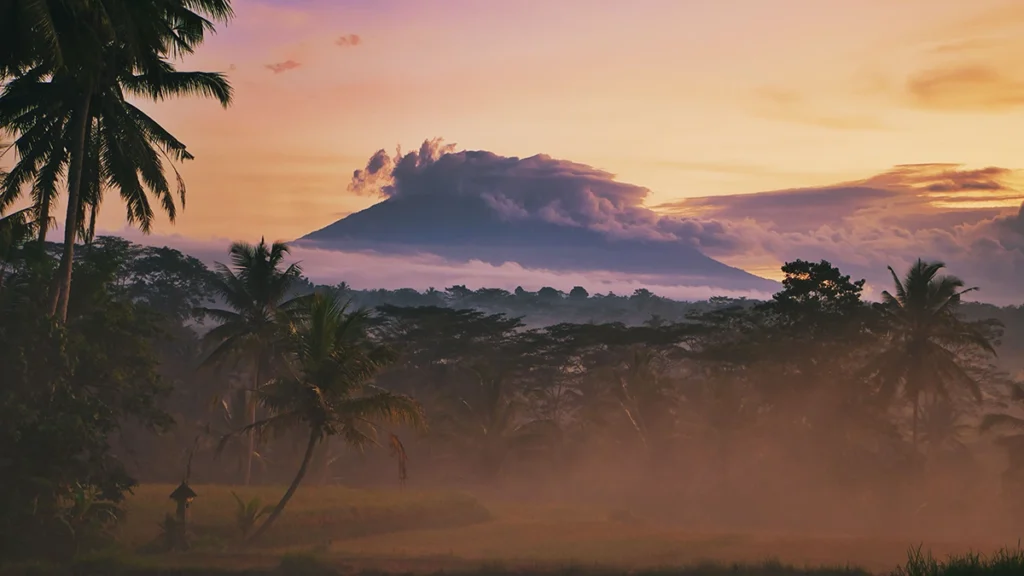Indonesia Travel Guide: Everything You Need to Know for 2024
Introduction
Welcome to Indonesia, a country of unparalleled diversity and beauty, boasting over 17,000 islands, each with its own unique blend of cultures, cuisines, and landscapes. This Ultimate Indonesia Travel Guide is your essential companion on a journey through a land where adventure and tranquility coexist. From the vibrant streets of Jakarta to the serene beaches of Bali, and the untouched wilderness of Papua, Indonesia promises a wealth of experiences for every traveler.
With its vast archipelago, Indonesia offers something for everyone; whether you’re a thrill-seeker, a culture enthusiast, a foodie, or just someone looking for a slice of paradise. Its diverse range of adventures includes trekking up smoldering volcanoes, diving into a vibrant underwater world, exploring ancient temples, and indulging in rich culinary delights.
As you read through our comprehensive guide, we’ll unveil the best times to visit, reveal the must-see destinations from renowned travel experts, provide detailed planning tools, and share essential travel tips from the community. Whether you’re planning your first trip or returning for more, this guide is packed with valuable insights to enhance your Indonesian adventure. Join us as we explore beyond the well-trodden paths of this enchanting destination and discover the heart and soul of Indonesia.
Visit Indonesia Indonesia’s Official Tourism Website
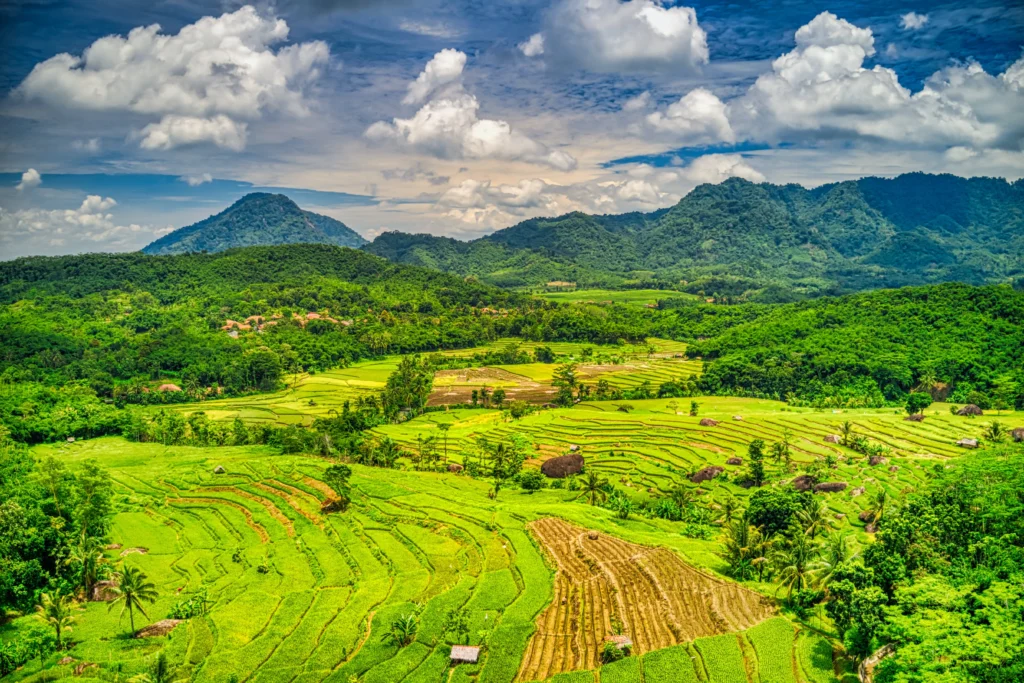
Planning Your Ultimate Indonesia Adventure
Embarking on an adventure to Indonesia requires a touch of planning to make the most of your experience. The very first thing to consider is the scope of the Indonesian archipelago, which stretches over an impressive 5,000 kilometers from west to east. This guide seeks to simplify that process, providing everything from visa assistance to expert recommendations for crafting an unforgettable itinerary.
Whether you’re drawn to the spiritual serenity of Bali’s temples, the prehistoric allure of Komodo dragons, or the bustling urban tapestry of Jakarta, planning tools are your best friend. They ensure that you can navigate the diverse offerings of this vast country with ease. With such a plethora of options at your fingertips, it’s important to narrow down your choices based on your interests, budget, and the time you have available.
Start by listing the places you’d like to visit and the experiences you dream of having. Do you want to delve into the local culture and history? Are Indonesia’s world-famous beaches calling your name, or are you more enticed by the opportunity to dive among some of the most biodiverse marine habitats on the planet? Once you have a clear idea of what you want from your trip, the next steps become much easier.
Resources and guidance for planning your trip are abundant online. Websites like Lonely Planet and TripAdvisor offer extensive information on a myriad of Indonesian attractions, while tools like Skyscanner can help you find the most affordable flights. Additionally, it’s crucial not to overlook the importance of travel insurance. With activities like diving and volcano trekking on many travelers’ agendas, ensuring you’re covered for any unforeseen events is a must.
Remember to bookmark Indonesia’s Ministry of Tourism for the latest updates on travel policies, and consider reaching out to local tour operators for in-depth knowledge and personalized experiences.
With a well-planned itinerary, you’re now ready to dive deeper into the details of when to visit, what to see, and how to prepare for your Indonesian escape.
When to Embark: The Best Time to Visit Indonesia
Choosing the best time to visit Indonesia hinges on understanding its tropical climate, characterized by two main seasons: the dry season and the rainy season. The dry season spans from May to September and is widely considered the best time to visit, particularly if you’re looking to explore the great outdoors, laze on sun-drenched beaches, or climb the many volcanoes.
During the dry season, humidity levels drop and rainfall is minimal, creating ideal conditions for diving, snorkeling, and surfing, especially in places like Bali, the Gili Islands, and Lombok. This period also aligns with the peak tourist season, meaning popular destinations can be crowded but also vibrant and full of life.
Conversely, the rainy season from October to April brings higher humidity and frequent downpours. However, this is also when Indonesia blooms into life, with lush landscapes and waterfalls at their most powerful. Moreover, the wet season can mean fewer tourists, more competitive prices, and the unique opportunity to see some of the country’s wildlife in action, especially in the rainforests of Sumatra and Borneo.
It’s worth noting that while these seasons are generally predictable, regional variations do exist. For instance, the eastern parts of Indonesia, including Papua and Maluku, have their own microclimates with differing wet and dry periods.
Here’s a snapshot of the yearly climate patterns to help you decide:
- Dry Season (May – September):
- Bali: Warm, sunny days; ideal for beachgoers and surfers.
- Java: Clear skies perfect for visiting temples and hiking.
- Sumatra: Dry weather favorable for trekking and wildlife spotting.
- Rainy Season (October – April):
- Borneo (Kalimantan): Rainforest blooms; great for river cruises and seeing orangutans.
- Sulawesi: Lush greenery and vibrant festivals.
- Raja Ampat: Manta ray season for divers.
Regardless of when you plan to visit, checking the regional weather forecasts and packing accordingly is always recommended. For a detailed look at Indonesia’s weather patterns and climate charts, refer to resources such as Weather Atlas.
Ultimately, the best time to visit Indonesia may vary depending on what’s on your travel wishlist, but there’s never a wrong time to discover the myriad wonders that this country has to offer.
Visa Information and Entry Requirements
Navigating the visa requirements for Indonesia is crucial for a hassle-free entry. Indonesia offers a variety of visa options, catering to tourists, business visitors, and long-term stays. Many travelers may be eligible for visa exemption or visa on arrival, depending on their nationality and the purpose of their visit.
Visa-exempt visitors can stay for up to 30 days, while those opting for a visa on arrival can also enjoy a 30-day stay, with the possibility to extend for an additional 30 days. It’s essential to check the latest visa policies before your trip, as regulations can change. The official website of the Directorate General of Immigration of Indonesia provides up-to-date and authoritative information on visa options.
Here are some standard requirements for most travelers visiting Indonesia:
- A passport valid for at least 6 months from the date of arrival.
- A return or onward ticket out of Indonesia.
- Evidence of sufficient funds to cover your stay.
For those planning a longer visit or have specific needs, such as engaging in educational activities or journalism, different types of visas like the Social/Cultural Visit Visa or Journalist Visa apply, and detailed information can be found on the Indonesian Embassy or Consulate websites in your respective countries.
Remember also to stay informed about health and vaccination requirements. With the current global health situation, additional entry conditions may include health declarations, proof of COVID-19 vaccinations, and even quarantine on arrival.
Lastly, respecting Indonesian laws and customs is paramount. Indonesia has stringent drug laws, and some regions have dress codes due to religious beliefs. Therefore, obtaining comprehensive travel insurance that covers medical emergencies, trip cancellations, and other unforeseen incidents is advised. Trusted sources for travel insurance include World Nomads and Squaremouth.
With proper planning and understanding of visa and entry requirements, you can look forward to an enriching Indonesian adventure, free of any legal hurdles.
Embarking to the Archipelago: How to Get to Indonesia
Indonesia is well-connected to the world through numerous international airports, with the most prominent being Soekarno-Hatta International Airport (CGK) in Jakarta, Ngurah Rai International Airport (DPS) in Bali, and Juanda International Airport (SUB) in Surabaya. Major airlines offer flights to Indonesia from various global hubs, making it a convenient destination for travellers worldwide.
When planning your trip to Indonesia, utilizing flight comparison tools like Skyscanner or Kayak can help you find the best routes and deals. Sustainable travel options are also available for eco-conscious travelers who prefer airlines with carbon offset programs or those looking to minimize their carbon footprint.
Upon arrival, it’s essential to consider the distance between islands and destinations within Indonesia. Domestic flights can often be the quickest way to travel long distances, with local carriers such as Garuda Indonesia, Lion Air, and AirAsia Indonesia providing extensive networks across the country.
Alternatively, ferries are a popular and often adventurous way to hop between islands, especially smaller ones not serviced by airports. The state-owned company Pelni operates passenger ships to many islands, and schedules can be found on their official website.
For a more intimate on-the-ground experience, trains are available on certain islands, like Java, with PT Kereta Api Indonesia being the primary operator. Buses also offer comprehensive routes and are usually more economical, albeit slower.
Ride-sharing services such as GoJek and Grab have grown in popularity in many Indonesian cities, providing convenient and budget-friendly options for getting around urban areas. If you’re comfortable on two wheels, scooter rentals are ubiquitous and offer a flexible way to explore, though ensure you possess an international driver’s license and are accustomed to the local driving conditions.
It’s a good idea to check the latest travel advisories, as infrastructure and transportation services can be affected by weather conditions and natural events. Websites like Traveloka can assist with booking internal flights, accommodations, and transportation in advance.
Navigating through Indonesia’s many islands may be challenging, but with careful planning and local knowledge, it can be an incredibly rewarding part of your journey.
Cultural Insights: Things to Know Before You Go
Traveling through Indonesia is not just a journey across land and sea, but an exploration of diverse cultures and traditions. Before you go, it’s important to gain some understanding of the customs and social norms to ensure a respectful and enriching experience.
Cultural Etiquette
Indonesians are known for their warmth and politeness, and as a visitor, mirroring this respectfulness is key. Greetings are often formal, with a nod or a smile, and using the right hand for gestures, such as eating and shaking hands, is preferred as it is considered clean and polite.
When visiting temples or religious sites, dressing modestly is essential. Cover shoulders and knees, and be prepared to remove your shoes. Always ask permission before taking photographs, especially of people.
Religious Diversity
Indonesia is home to multiple religions, with the largest being Islam, followed by Christianity, Hinduism, and Buddhism. It’s common to hear calls to prayer throughout the day in Muslim-majority areas. During the holy month of Ramadan, be mindful that many locals fast from dawn until sunset. Non-Muslim travelers are not expected to fast, but eating and drinking in public during daylight hours should be done discreetly.
Safety
Indonesia is generally considered safe for tourists. However, as with any travel destination, it’s important to take standard safety precautions. Keep an eye on your belongings, be cautious when withdrawing money from ATMs, and avoid walking alone at night in less populated areas.
Local Laws
Be aware that Indonesia has strict drug laws with severe penalties. Always respect local traditions and laws, as they can vary between regions, especially in places like Aceh where Sharia law is implemented.
Health and Hygiene
Tap water in Indonesia is not potable, so always drink bottled water or water that has been boiled and filtered. “Bali belly,” a common term for traveler’s diarrhea, can be avoided by practicing good food and water safety.
Language
While the official language is Bahasa Indonesia, over 700 languages are spoken across the islands. Learning a few basic phrases in Bahasa Indonesia will go a long way in showing respect and building rapport with locals.
A few useful phrases:
- Hello: “Halo”
- Thank you: “Terima kasih”
- Yes: “Ya”
- No: “Tidak”
- Excuse me: “Permisi”
- Goodbye: “Selamat tinggal”
Connectivity
Staying connected is easy in Indonesia, with SIM cards and mobile data widely available. Major providers like Telkomsel have extensive coverage, even in remote areas. Wi-Fi is commonly found in hotels, cafes, and restaurants.
As you immerse yourself in Indonesia’s rich cultural tapestry, remember that being informed, respectful, and open-minded will enhance your travel experience significantly. For a deeper dive into Indonesia’s cultural nuances, the Culture Trip website offers a wealth of information that can help enrich your understanding of this fascinating country.
Indonesia’s Top Destinations and Hidden Gems
With over 17,000 islands, Indonesia is a treasure trove of destinations waiting to be explored. From the bustling streets of Jakarta to the tranquil shores of Raja Ampat, this guide will highlight both popular hotspots and lesser-known retreats. Here’s a glimpse into the places that make Indonesia a top travel choice.
Tourist Favorites
Bali is often the star of Indonesia travel, known for its lush landscapes, vibrant culture, and beautiful temples. Ubud, at the heart of Bali, offers artistic flair, with traditional dance performances, crafts, and the iconic Tegalalang Rice Terraces.

Lombok and the Gili Islands provide a serene escape, offering white sandy beaches, clear blue waters, and a slower pace of life. Don’t miss diving and snorkeling here, where tropical marine life abounds.

Java is rich in history with the magnificent Borobudur and Prambanan temples. Yogyakarta, a cultural hub, is your gateway to these ancient marvels.
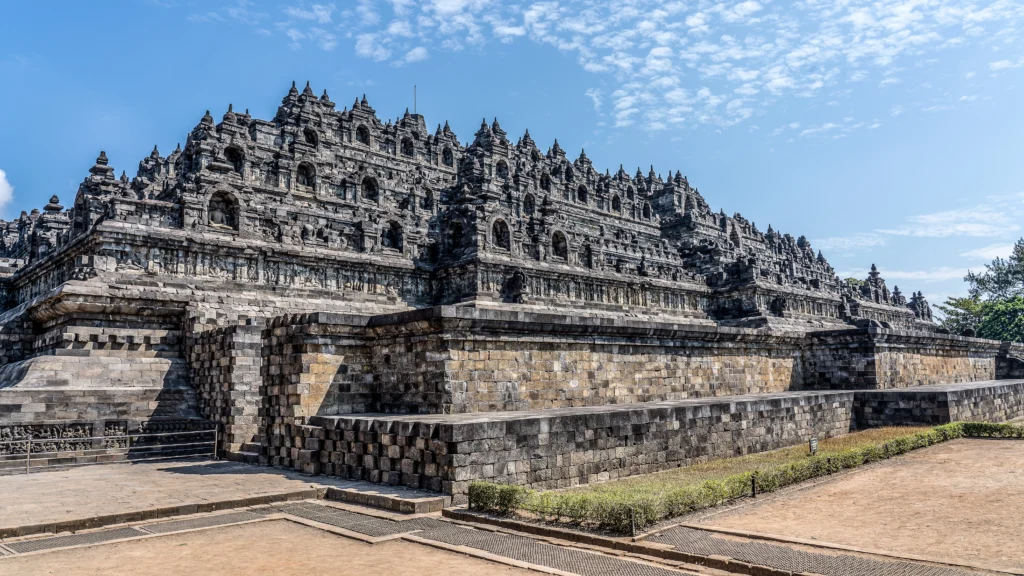
Off the Beaten Path
Sumatra is home to stunning rainforests and unique wildlife like the Sumatran orangutan. Visit Bukit Lawang for a chance to see these magnificent creatures in their natural habitat.
Flores offers a different kind of allure with its tri-colored volcanic lakes at Mount Kelimutu and rustic charm in villages like Wae Rebo.
Raja Ampat, a remote archipelago in West Papua known for its pristine dive sites, is a paradise for underwater enthusiasts, with an incredibly diverse marine life that makes it part of the Coral Triangle.
Sulawesi, where tradition meets natural beauty, is famed for the elaborate funeral ceremonies of Tana Toraja and the stunning underwater ecosystems of Bunaken National Marine Park.
The Banda Islands, once known as the Spice Islands, are not just rich in history but also incredible snorkeling spots with crystal-clear waters and abundant coral gardens.
Hidden Treasures
Kawah Ijen in East Java, famous for its electric blue flames and turquoise crater lake, offers an otherworldly hiking experience.
The Togean Islands, nestled in the Gulf of Tomini, are a haven for divers and anyone seeking a digital detox, with undeveloped islands and a laid-back atmosphere.
Belitung boasts stretches of white sand beaches and granite rock formations that protrude from its clear coastal waters, perfect for a peaceful getaway.
Sumba is a mystical island with traditional villages, untouched beaches, and megalithic tombs, providing a glimpse into a preserved ancient culture.
Mentawai Islands attract surfers from all over the world with their perfect waves and remain relatively untouched by mass tourism.
Whether you choose to follow the well-trodden path or blaze your own trail, the diversity of experiences in Indonesia ensures that every traveler’s itinerary can be as unique as they are. To start pinning these destinations on your map, Wonderful Indonesia provides detailed information and inspiration to fuel your travel plans.
Indonesia is not a destination you simply visit; it’s a place where you engage and create unforgettable memories. Whether you’re gazing at the sunrise over a volcano’s edge or exploring the depths of a coral reef, each moment here resonates with a sense of discovery.
Itinerary Highlights: Crafting Your Personalized Indonesia Experience
Creating a personalized itinerary in Indonesia means balancing your interests with the opportunities each destination offers. Whether you have three days or three weeks, here’s how you can build an itinerary that reflects the richness of your chosen destinations, keeping in mind the distances and travel times between them.
Sample 3-day Itinerary: Jakarta and Surroundings
Day 1: Jakarta
- Explore the historical Old Town (Kota Tua).
- Visit the National Monument (Monas) and the National Museum.
- Sample local cuisine at a street food stall or café.
Day 2: Thousand Islands (Pulau Seribu)
- Take a day trip from Jakarta to these nearby islands.
- Snorkel or dive to see coral reefs and marine life.
- Relax on a quiet beach and enjoy grilled seafood.
Day 3: Bogor or Bandung
- Visit the Bogor Botanical Gardens or hike in Mount Halimun Salak National Park.
- Alternatively, head to Bandung for a volcano tour or to enjoy the cooler climate and artsy café scene.
Sample 1-week Itinerary: Bali and Lombok
Day 1-3: Bali
- Start in Ubud with its art galleries, rice terraces, and monkey forest.
- Take a day to explore Tanah Lot and Uluwatu temples along the coast.
- Enjoy the vibrant nightlife of Seminyak or the relaxed vibes of Canggu.
Day 4-5: Gili Islands
- Take a fast boat to the Gili Islands.
- Go snorkeling or diving, cycle around Gili Trawangan, or just relax on the beach.
- Enjoy the car-free, serene setting of Gili Meno or Gili Air.
Day 6-7: Lombok
- Trek to the Sendang Gile and Tiu Kelep waterfalls.
- Visit local villages and craft markets.
- If adventurous, start a hike to Mount Rinjani.
Sample 2-week Itinerary: Java, Bali, and Komodo
Day 1-3: Yogyakarta (Java)
- Visit Borobudur and Prambanan temples.
- Explore the city’s cultural heritage and shop for batiks.
Day 4-5: Mount Bromo (Java)
- Experience sunrise over Mount Bromo.
- Take a jeep tour of the Sea of Sand and Savannah.
Day 6-7: Ubud (Bali)
- Cultural immersion in Bali’s artistic capital.
- Indulge in wellness activities like yoga and spa treatments.
Day 8-10: Bali Beaches
- Relax in Nusa Dua, Jimbaran, or the southern Bukit Peninsula.
- Surf in Kuta or enjoy family-friendly activities in Sanur.
Day 11-14: Komodo National Park
- Fly to Labuan Bajo (Flores) and embark on a multi-day boat trip.
- See the Komodo dragons, snorkel in Pink Beach, and visit Padar Island.
While these itineraries offer a glimpse into what’s possible, the true beauty of Indonesia is that it allows for spontaneity and personalization. Whether it’s a quest for the ultimate beach, a cultural deep-dive, or an off-grid adventure, your itinerary can be as unique as the archipelago itself.
For detailed destination guides and itinerary planning tools, consider checking out resources like The Lonely Planet’s Indonesia travel guide or TripSavvy’s Indonesia sections for inspiration and practical advice.
Indonesia Travel Costs: Financial Planning for Your Trip
Traveling in Indonesia can cater to a wide range of budgets, from the backpacker looking to stretch their dollars to the luxury traveler seeking opulent experiences. Understanding the costs associated with various aspects of travel will help you plan a financially savvy itinerary.
Accommodation
Budget Options: Hostels and guesthouses are plentiful, particularly in tourist areas. Expect to pay anywhere from $6 to $20 per night for a dorm bed or a basic private room.
Mid-range Options: For a bit more comfort, boutique hotels and bungalows can range from $20 to $100 per night, offering amenities like air conditioning, hot water, and breakfast.
Luxury Options: High-end resorts and villas are also ubiquitous, especially in Bali and Jakarta. Prices can start at $100 and go up to several hundred dollars per night, providing premium facilities and services.
Food and Drink
Street Food and Local Eateries: Meals can be as low as $1 to $4, offering delicious local dishes like nasi goreng (fried rice), mie goreng (fried noodles), and sate (skewered meats).
Mid-range Restaurants: For a sit-down meal with service, prices typically range from $5 to $15 per person.
High-end Dining: Upscale restaurants, particularly in tourist areas and five-star hotels, can cost $20 and upwards for a meal.
Transportation
Local Transport: Public buses and city transport like Bajaj or Becak can cost less than a dollar for short trips. Ride-sharing apps like Gojek or Grab are prevalent in cities and offer affordable rides.
Domestic Flights: Flights between islands vary widely, from $30 one-way for short hops to $100 or more for longer distances, especially when booked last minute.
Ferries and Boats: Island-hopping on ferries can be incredibly affordable, with some journeys costing only a few dollars. Private boat rentals for diving or touring will be more expensive but can be cost-effective for groups.
Activities and Entrance Fees
Tourist Attractions: Entrance fees for temples, national parks, and museums are relatively modest, often between $1 to $25.
Adventure Activities: Guided tours, such as diving or trekking, can start from $30 and go up to several hundred dollars for multi-day excursions with equipment rental included.
Cultural Activities: Traditional dance shows, cooking classes, and craft workshops can range from $10 to $50, depending on the experience’s exclusivity.
Budgeting Tips
- Eat Local: Embrace street food and small local warungs (cafes) for authentic, affordable meals.
- Travel Slowly: Taking your time in one location can save on transport costs and often leads to discovering hidden gems.
- Share Costs: Group tours or shared taxis can split the expense, making activities more affordable.
- Book in Advance: Flights, particularly domestic ones, are cheaper when booked in advance. The same goes for some accommodations.
- Use Cash Wisely: While ATMs are widely available, having enough cash when traveling to remote areas is essential, as not all places accept cards.
For a more detailed breakdown of costs and average prices for various travel services in Indonesia, Price of Travel provides a useful database of information. Additionally, travel forums like TripAdvisor’s Indonesia Forum can offer up-to-date insights and tips from fellow travelers.
Knowing the costs associated with your Indonesia trip can take away the financial guesswork, allowing you to focus on immersing yourself in the incredible experiences the country has to offer.
Accommodation Insights: Where to Stay in Indonesia
Choosing the right accommodation in Indonesia can significantly enhance your travel experience. Whether you prefer the charm of a beachfront villa, the social atmosphere of a hostel, or the luxury of a five-star resort, Indonesia offers a plethora of options to suit every preference and budget.
Budget-Friendly Stays
For those traveling on a tight budget, hostels are a fantastic way to save money and meet fellow travelers. Not only are they cost-effective, with prices as low as $6 per night, but many offer added amenities like Wi-Fi, communal kitchens, and even pools. Guesthouses, known locally as “losmen” or “penginapan,” provide private rooms at affordable rates and often include breakfast.
Mid-Range Accommodations
Mid-range hotels and boutique resorts offer a balance between comfort and cost, with prices ranging from $20 to $100 per night. These establishments typically provide air-conditioned rooms, on-site dining options, and additional facilities such as swimming pools and spas. Eco-lodges, especially in places like Ubud or near national parks, provide a sustainable choice for environmentally conscious travelers.
Luxury Retreats
For those seeking indulgence, Indonesia’s luxury resorts and private villas deliver unparalleled elegance and service. With prices starting at $100 and stretching into the thousands, these opulent accommodations often feature private beaches, personal butlers, and world-class dining experiences. International chains like the Four Seasons, Aman Resorts, and St. Regis have properties in prime locations like Bali and Jakarta.
Unique and Cultural Options
Beyond standard hotels, Indonesia offers unique accommodations that allow travelers to immerse themselves in local culture. Homestays with local families provide insight into Indonesian life, while traditional “rumah adat” stays offer a historical perspective. For the adventurous, overnight stays in treehouses and jungle bungalows provide a close connection to nature.
Booking Tips
- Book in Advance: Especially during peak tourist seasons, booking your accommodation early can secure better rates and availability.
- Check Reviews: Platforms like Booking.com and Airbnb offer extensive reviews to help you make informed decisions.
- Consider Location: Proximity to attractions, dining options, and public transport can significantly impact your experience.
- Negotiate Rates: In less touristy areas or during the off-season, negotiating the price of your stay could result in discounts.
- Understand Amenities: Ensure you’re aware of what’s included in the price, such as airport transfers, breakfast, or Wi-Fi access.
Regardless of where you choose to stay, making accommodations a thoughtful part of your travel planning can lead to a more comfortable and memorable visit to Indonesia.
Navigating the Islands: Getting Around Indonesia
Indonesia’s vastness and the spread of its many islands pose unique challenges for getting around, but also present diverse and exciting transport options. From traditional boats to modern ride-sharing services, understanding the modes of transportation can make your travel within the country smooth and enjoyable.
Air Travel
With more than 250 airports across the archipelago, flying is one of the fastest ways to cover large distances in Indonesia. Domestic airlines like Garuda Indonesia, Lion Air, and Citilink service major and minor airports, ensuring that even remote areas are accessible. Booking flights in advance often secures the best fares, but be sure to check airline safety records and consider carbon offsetting for a more sustainable journey.
Sea Travel
Connecting the islands by sea is a quintessential Indonesian experience. The state ferry system, operated by Pelni, offers affordable passage between islands on both passenger and cargo ships. For more localized travel, such as hopping between the Gili Islands and Bali, speedboats and charter services are available.
Land Transportation
On the larger islands like Java and Sumatra, buses and trains are prevalent for intercity travel. Trains in Java are comfortable and scenic, especially in executive class, while buses reach more destinations and can be a cheaper alternative.
Ride-Sharing and Local Transport
Ride-sharing apps like Gojek and Grab have revolutionized urban travel in Indonesia, providing safe and affordable rides on both two and four wheels. Traditional transport options like the three-wheeled ‘bajaj’, horse-drawn ‘andong’, or the ubiquitous ‘ojek’ (motorcycle taxis) offer an authentic local experience.
Driving and Renting
While renting a car or scooter gives you the freedom to explore at your own pace, be cautious of traffic conditions and local driving habits. Ensure you have an international driver’s license and are comfortable with the rules of the road, and always wear a helmet when riding a scooter.
Tips for Getting Around Indonesia
- Plan Ahead: For remote destinations or during high seasons, booking transport in advance is crucial.
- Use Local Knowledge: Engage with locals or accommodation hosts to find the best options for regional transport.
- Stay Flexible: Delays are common, so always allow extra time for travel, especially when catching flights.
- Safety First: Choose reputable operators, especially for activities like diving or boat trips.
- Insurance: Confirm that your travel insurance covers transport-related incidents for peace of mind.
Navigating Indonesia’s transportation network can be part of the adventure; embrace it with preparation and an open mind. For reliable transportation bookings and timetables, check platforms like 12go.asia or Traveloka.
Health in Indonesia: Staying Healthy and Safe
Maintaining good health while traveling in Indonesia is paramount for a pleasant trip. Given the tropical climate and the various environments you might encounter, being prepared for health-related issues is a wise step. Here are important considerations to keep in mind:
Vaccinations and Preventive Measures
Before traveling to Indonesia, consult with a travel health specialist about recommended vaccinations, which may include shots for hepatitis A and B, typhoid, cholera, rabies, and Japanese encephalitis, depending on your itinerary. Additionally, malaria prophylaxis might be advised for travel to certain areas like Papua or remote parts of Sulawesi and Kalimantan.
Common Health Concerns
Traveler’s Diarrhea: Familiarly dubbed “Bali Belly,” can be avoided by drinking bottled or boiled water, eating food that is cooked and served hot, and frequently washing hands with soap.
Dengue Fever: Transmitted by mosquitoes, dengue is present in Indonesia. Use insect repellent, wear long-sleeved clothing, and stay in places with air conditioning or window and door screens.
Sun Protection: The sun can be intense in this equatorial region, so use high-SPF sunscreen, hats, and sunglasses to guard against sunburn and heatstroke.
Medical Facilities
While primary medical care is available throughout Indonesia, the quality and availability of care can vary widely, particularly once you’re outside major cities. International-standard hospitals are found in Jakarta, Bali, and Surabaya, but it’s advisable to know the location of clinics and hospitals in each area you visit.
Health Insurance
Investing in comprehensive travel health insurance is a must, as it ensures that you’re covered for any medical emergencies, evacuations, or unexpected treatment costs. Companies like World Nomads and SafetyWing offer specialized plans for travelers.
Practical Tips for Staying Healthy
- Always carry a first-aid kit with essential medications.
- Stay hydrated, but ensure the water is safe to consume.
- Be cautious with street food; opt for busy stalls where high turnover indicates freshness.
- Familiarize yourself with local health risks and take necessary precautions.
By prioritizing your health and preparing for potential risks, you can enjoy all the beauty and adventure Indonesia offers without significant health concerns impeding your journey.
Experiencing Indonesian Cuisine: A Culinary Expedition
Indonesian cuisine is as diverse as its islands, a fusion of flavors influenced by a rich history of trade, colonization, and cultural exchange. From fiery sambals to fragrant curries and sweet desserts, the archipelago is a food lover’s paradise.
Must-Try Dishes
Nasi Goreng: This quintessential Indonesian fried rice is often considered the national dish. Typically flavored with kecap manis (sweet soy sauce), garlic, tamarind, and a mix of meat and vegetables, it’s a dish that can be found everywhere, from street vendors to high-end restaurants.

Rendang: Originating from West Sumatra, rendang is a spicy and rich meat curry. Cooked slowly in coconut milk and a mixture of lemongrass, galangal, garlic, turmeric, ginger and chilies, it’s recognized for its complex flavor and tender texture.

Satay: These skewered and grilled meats are a staple street food across Indonesia. They’re typically served with a variety of sauces, the most popular being a rich peanut sauce.
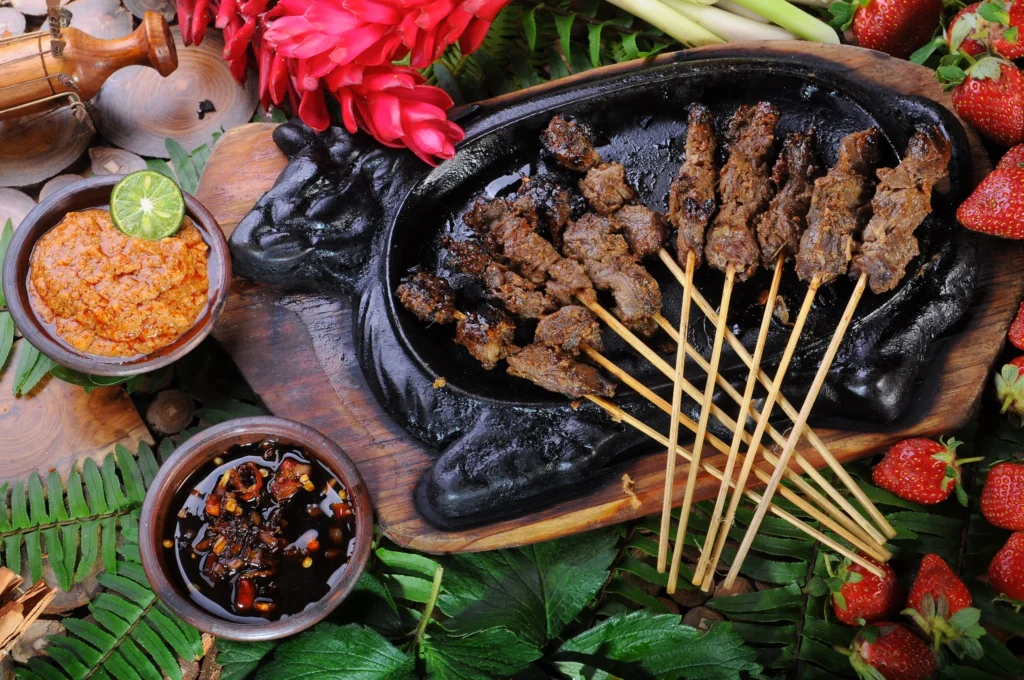
Gado-Gado: A traditional salad made with a mix of steamed vegetables, hard-boiled eggs, fried tofu, and tempeh, all covered in a peanut sauce dressing.

Culinary Experiences
To truly immerse yourself in the culinary culture of Indonesia, consider taking a cooking class where you can learn traditional recipes and techniques. Markets, such as the ones in Ubud or Yogyakarta, are excellent places to explore local ingredients and taste fresh fruits and snacks.
For a gourmet experience, Indonesia has an emerging fine dining scene that interweaves local flavors with global culinary trends, particularly in Bali and Jakarta. Restaurants like Locavore in Ubud and Namaaz Dining in Jakarta offer unique takes on Indonesian cuisine.
Finding The Best Food
- Local Warungs: These small, often family-run eateries, provide authentic dishes at affordable prices.
- Street Food Markets: Places like Jakarta’s Glodok and Bali’s Gianyar Night Market are havens for foodies.
- Food Apps: Use apps like Zomato or Traveloka Eats to discover top-rated eateries and get reviews from locals and tourists alike.
Adventure and Leisure: Indonesia’s Array of Activities
Indonesia offers an abundance of activities for thrill-seekers and those seeking relaxation alike. Whether you’re looking to immerse yourself in the underwater world, trek through lush landscapes, or partake in cultural festivities, there’s something for everyone.
Underwater Adventures
Scuba Diving and Snorkeling: Indonesia’s waters are part of the Coral Triangle, known for their biodiversity. Top diving destinations include Raja Ampat, Komodo National Park, and the waters around Bali like Menjangan Island. Experience vibrant coral reefs, manta rays, and colorful fish species.
Surfing: With its many islands, Indonesia is a surfer’s paradise. Bali’s Kuta and Uluwatu are famous for their waves, as are the Mentawai Islands and the breaks of Sumatra and Java.
On Land
Trekking and Hiking: Indonesia’s volcanic landscape provides numerous trekking opportunities. Sunrise hikes to Mount Bromo in Java or Mount Batur in Bali are popular. For a more challenging adventure, consider the multi-day trek to the summit of Mount Rinjani on Lombok.
Cultural Experiences: Witnessing traditional dance performances, crafts, and ceremonies gives visitors a glimpse into Indonesia’s soul. Ubud in Bali is a cultural center where you can enjoy these expressive arts.
Bespoke Activities
Yoga Retreats: Bali, particularly Ubud, is renowned for its yoga and wellness retreats – perfect for those seeking a spiritual and body rejuvenating experience.
Wildlife Encounters: Sumatra’s Bukit Lawang offers guided treks to see orangutans in their natural habitat, while Komodo National Park lets you get up close with the prehistoric Komodo dragons.
Tailoring Your Trip
To ensure your activities align with your interests:
- Research and Book in Advance: Especially for popular activities like diving or guided treks.
- Check the Season: Ensure that your planned activities are suitable for the current weather and sea conditions.
- Ask Locals: They can often suggest hidden gems or the best times to visit certain spots.
Staying Connected: Communication and Local Guide Interaction
Communication is key to a smooth and fulfilling travel experience in Indonesia. From staying in touch with loved ones to navigating through unfamiliar territories, ensuring you have reliable methods of communication is essential.
Mobile Connectivity
Most travelers to Indonesia will find it convenient to purchase a local SIM card for their mobile phones. Providers like Telkomsel, XL Axiata, and Indosat Ooredoo offer good coverage, even in some remote areas, and data packages are typically affordable. SIM cards can be bought at the airport, convenience stores, or dedicated phone shops.
Before purchasing a SIM card, ensure that your phone is unlocked and compatible with Indonesian networks. You’ll also need to register the SIM card using your passport, as per local regulations.
Internet Access
Wi-Fi is widely available in urban areas, tourist spots, and most accommodation types, from budget hostels to luxury resorts. However, the quality of the connection can vary, and in more remote destinations, internet access may be limited or unreliable.
For those who need to stay connected for work or other reasons, consider carrying a portable Wi-Fi device or renting one upon arrival. Alternatively, ensure that your accommodation provides adequate Wi-Fi, particularly if traveling to off-the-beaten-path locations.
Communicating with Locals
While Bahasa Indonesia is the national language, many Indonesians in tourist areas are proficient in English, making communication relatively easy for English-speaking travelers. Learning a few key phrases in Bahasa Indonesia, however, will be greatly appreciated by locals and can enrich your interactions.
Some useful phrases include:
- Hello: “Halo”
- Thank you: “Terima kasih”
- Please: “Tolong”
- Yes: “Ya”
- No: “Tidak”
- How much?: “Berapa harga?”
Engaging Local Guides
Local guides can provide invaluable insights into Indonesian culture, history, and best-kept secrets. When visiting specific attractions, national parks, or remote areas, hiring a local guide can enhance the experience and is often a responsible way to contribute to the local economy.
For hiring reputable guides:
- Check reviews on platforms like TripAdvisor or TourHQ.
- Ask for recommendations from your accommodation or fellow travelers.
- Agree on clear terms, including the price and scope of the guide’s services, beforehand.
By taking the necessary steps to stay connected and communicate effectively, you can navigate Indonesia with confidence, forging deeper connections with the people you meet along the way.
Capturing the Highlights of Indonesia
Documenting your Indonesian journey through photography not only preserves memories but also captures the essence of this vibrant country. However, it’s important to remain respectful and tactful when wielding a camera, especially in culturally sensitive areas.
Photography Etiquette
Ask for Permission: When photographing people, always ask for their consent first. It’s a simple act of respect that goes a long way.
Be Discrete: Avoid taking photos in sacred or private places, such as inside temples during ceremonies, unless you have explicit permission.
Respect the Environment: While capturing the natural beauty, be mindful not to disturb wildlife or damage habitats – keep to designated paths and follow conservation guidelines.
Best Practices for Travel Photography
Golden Hours: Take advantage of the soft light during sunrise and sunset to enhance your landscape and portrait shots.
Local Life: Streetscapes, markets, and everyday interactions offer a glimpse into the Indonesian way of life. Capture these moments to tell a story with your photos.
Cultural Events: With a calendar full of festivals and ceremonies, there’s ample opportunity to photograph Indonesia’s rich cultural tapestry. Prioritize capturing the atmosphere and emotion of the events.
Landscapes: From the terraced rice fields of Bali to the majestic volcanoes of Java, Indonesia’s landscapes are photogenic. Use a tripod for stability and play with compositions to frame the perfect shot.
Equipment Tips
- Protection: Keep your gear protected from the elements – a waterproof bag or case is crucial in tropical climates prone to sudden downpours.
- Backup: Always have extra batteries and memory cards, as it may be difficult to purchase these in remote areas.
- Versatility: A good zoom lens can be invaluable, allowing you to capture a wide range of subjects without changing lenses constantly.
Sharing Your Memories
While it’s tempting to share your experiences in real-time on social media, consider the privacy and wishes of those who may feature in your photos. When sharing images online, tagging your location or using relevant hashtags can inspire others but be cautious of geotagging sensitive or undisclosed locations.
Indonesia is a photographer’s delight, offering a rich palette of subjects, from vibrant coral reefs to mist-covered mountaintops. By photographing with sensitivity and mindfulness, you can take home a portfolio of images that truly reflect the beauty and spirit of this incredible country.
Before You Leave: Departure Tips and Farewells
As your Indonesian adventure draws to a close, a smooth departure process can help you leave with nothing but fond memories. Here are some tips to consider as you prepare to bid “Selamat Tinggal” to Indonesia.
Packing and Preparation
- Check Weight Limits: Airlines have strict baggage weight limits. Recheck your allowance and consider the need for extra baggage if you’ve made significant purchases.
- Souvenirs: Pack any delicate items securely within your luggage to prevent damage during transit.
- Local Products: Remember that certain goods, especially agricultural products or cultural artifacts, may have export restrictions. Check customs regulations to avoid any issues at the airport.
Airport Arrangements
- Arrive Early: For international flights, arriving 2-3 hours before departure is advisable, as security checks and immigration can be time-consuming.
- Tax Refunds: If applicable, process any tax refund claims for purchases made in Indonesia at the designated counters before checking in.
- Departure Tax: As of now, departure tax is usually included in your ticket price, but it’s worth double-checking to avoid surprises at the airport.
Cultural Farewells
- Thank Your Hosts: If staying at a homestay or guesthouse, a small token of appreciation or even a simple “Terima kasih” (Thank You) goes a long way.
- Last-Minute Memories: Take the time to enjoy a final Indonesian meal or a leisurely stroll through a local market before heading to the airport.
Leaving Responsibly
- Sustainable Departure: Ensure you leave no trace behind by disposing of any waste properly and considering a carbon offset for your flight home.
- Reflect on Experiences: Take a moment to reflect upon and document your experiences while they’re fresh in your mind. This can provide valuable feedback for future travelers and for your own reminiscence.
Staying Connected
- Follow-Up: Exchange contact details with the friends and local contacts you’ve made. Social media makes it easy to stay in touch and share your journey’s highlights.
- Leave Reviews: Help future travelers by leaving honest reviews of the accommodations, restaurants, and services you experienced during your stay.
Departing from Indonesia can be bittersweet, but with these tips in mind, you can ensure your exit is as hassle-free as the rest of your journey.
FAQs: Answers to Common Questions About Traveling in Indonesia
Traveling to a new destination often comes with a host of questions. Here are answers to some frequently asked questions about traveling in Indonesia to help you prepare for your trip.
Do I need a visa to travel to Indonesia?
Many nationalities can enter Indonesia visa-free for short visits of up to 30 days. Others may be eligible for a visa on arrival, also for up to 30 days. Always check the latest visa regulations with the Indonesian embassy or consulate in your country before traveling.
Can I drink tap water in Indonesia?
It’s not safe to drink tap water in Indonesia. Stick to bottled water or water that has been filtered and purified. Most hotels and restaurants provide drinking water that’s safe for consumption.
What’s the best way to travel between islands in Indonesia?
Air travel is the quickest and most efficient way to travel between islands, particularly for long distances. Ferries are a good option for shorter distances or when traveling on a budget. Always ensure that the service providers follow safety standards.
Is Indonesia safe for solo female travelers?
Indonesia is generally safe for solo female travelers, especially in tourist areas. However, it’s always important to take precautions: dress modestly, avoid isolated areas at night, and be aware of your surroundings.
Is it necessary to have travel insurance for Indonesia?
Yes, it’s highly recommended to have comprehensive travel insurance that covers medical expenses, trip cancellations, and any activities you plan to do, like diving or hiking.
What should I pack for a trip to Indonesia?
Pack light, breathable clothing for the humid tropical climate, along with a sturdy pair of walking shoes. Don’t forget essentials like sunscreen, insect repellent, a hat, and swimwear. A raincoat or umbrella can be useful during the rainy season.
How do I access the internet in Indonesia?
Wi-Fi is widely available in tourist areas and in most hotels and cafes. For constant connectivity, consider purchasing a local SIM card with a data package.
What’s the local currency, and where can I exchange money?
The local currency is the Indonesian Rupiah (IDR). Money can be exchanged at banks, hotels, and authorized money changers. ATMs are commonly available in urban areas.
Can I use my credit cards in Indonesia?
Credit cards are widely accepted in major cities and tourist destinations, but always have cash on hand for smaller establishments or rural areas.
What are the customs and traditions I should be aware of?
Indonesian culture values respect and modesty. Dress conservatively, especially when visiting religious sites. Understand and adhere to local customs and traditions, which can vary significantly from one region to another.
Conclusion
Embarking on a journey to Indonesia offers an expansive canvas of experiences, from the vibrancy of its cities to the tranquil beauty of its islands. This Ultimate Indonesia Travel Guide has aimed to provide you with a comprehensive companion to this diverse country, equipping you with the knowledge to navigate its landscapes, cultures, and cuisines with ease.
Indonesia’s allure lies in its diversity, where each island tells a different story, each meal reveals a new flavor, and every encounter leaves a lasting impression. Whether it’s waking up to the call of the wild in Sumatra, diving into the rich marine life of Raja Ampat, or soaking in the spiritual ambiance of Bali’s temples, your Indonesian journey is sure to be as rewarding as it is enlightening.
Travel here is an opportunity to push your boundaries, indulge your senses, and connect with a world that’s as warm and welcoming as it is mysterious and thrilling. Each visit, whether it’s your first or your tenth, peels back another layer of Indonesia’s rich tapestry, leaving you with the certainty that there’s always more to explore.
So pack your bags, set your spirit of adventure free, and let Indonesia captivate your heart. The memories you’ll create here are destined to be as unforgettable as the archipelago itself.
Selamat jalan, or ‘have a good journey’, as you embark on your incredible Indonesian adventure!

